Last Updated on January 13, 2024 by Greg Gillson
Did you see a brightly-colored red bird, orange bird, or yellow bird in Colorado and wonder what it was?
This page is for you!
This article shows you photos and identification of some of the most common birds in Colorado based on color.
The list of birds found in Colorado includes over 510 species. So, I can’t show you all of them. I’m going to assume that you saw a common bird of this color, but you certainly could have seen something less common, or even rare!
Shape (including the shape of the bill) and size are often more helpful in starting to identify a bird than the color. In fact, most birds in North American can be easily identified with a black-and-white photo!
Many birds are multi-colored, so that it may be hard to pick out a dominant color. Males and females may be colored quite differently. And some color patterns are similar among otherwise dissimilar species.
Nevertheless, I’m going to try to pick out some of the birds that you are most likely to see in backyards or towns. And I’ll show a few others that I get asked about a lot.
The birds with a noticeable amount of red on them in Colorado covered in this article are:
- American Robin
- House Finch
- Broad-tailed Hummingbird
The birds with a noticeable amount of orange on them in Colorado covered in this article are:
- Northern Flicker
- Barn Swallow
- Spotted Towhee
- American Kestrel
- Red-breasted Nuthatch
- Bullock’s Oriole
- Ruddy Duck
- Black-headed Grosbeak
- Rufous Hummingbird
- Cooper’s Hawk
The birds with a noticeable amount of yellow on them, including lots of yellow and black birds, in Colorado covered in this article are:
- Western Meadowlark
- American Goldfinch
- Yellow-rumped Warbler
- Yellow Warbler
- Pine Siskin
- Western Kingbird
- Lesser Goldfinch
- Western Tanager
- Common Yellowthroat
- Yellow-breasted Chat
- Cedar Waxwing
- Yellow-headed Blackbird
Red birds of Colorado
Birds get the red, orange, and yellow in their feathers from carotenoids in the fruit, seeds, and plants they eat (source).
These carotenoid colors combine with melanin to form an infinite range of red feathers–pink, rusty, scarlet, violet, red-orange.
The following are red birds that you are most likely to see in Colorado.
American Robin
These are familiar lawn birds with red breasts.
 |
| American Robin. Greg Gillson. |
Male American Robins are brownish-gray above with a brick red breast. Females are paler orange below and paler gray above.
They are widespread in open country with scattered deciduous trees, residential areas.
American Robins are year-round residents throughout Colorado.
House Finch
When people ask about a bird with a red head at their feeder, it is usually this bird.
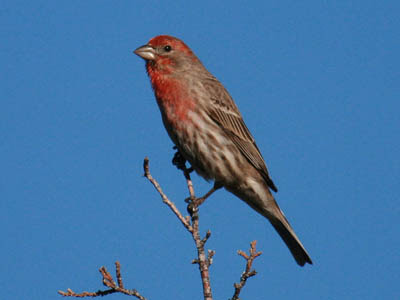 |
| Male House Finch. Greg Gillson. |
Males of this dusty brown striped finch have red limited to the head (specifically the forehead and eyebrow), breast (chest), and rump. The red coloration tends toward orangish, and may rarely be yellowish.
Females are streaked, similar to the males but without red. They lack any strong pattern on the face and head.
Note the small round head and curved upper ridge on the bill.
Some people call these red-headed sparrows. Sparrows and finches are similar, but in general, male finches are brighter than the females and tend to hang out more in trees. Sparrow genders are usually quite similar in coloration and tend to feed mostly on the ground.
These birds are common in residential areas, especially at bird feeders. In the West more widespread in arid regions near water.
House Finches are year-round residents throughout most of Colorado, absent in extreme northeastern Colorado.
Broad-tailed Hummingbird
These hummingbirds of the mountain West have rosy-red throats.
 |
| Broad-tailed Hummingbird. Michelle Lynn Reynolds. CC BY-SA 3.0 |
Both genders are green above, white below, with green and buff flanks. Rusty bases to outer tail feathers.
Males have bright red throats.
Found in dry pine and montane forests.
Broad-tailed Hummingbirds are summer residents in higher elevations of western Colorado.
Orange birds of Colorado
True orange-colored birds are not that common. Many birds that I have here are paler rusty.
The common pattern is an orange body and black or brown wings and tail. Another common pattern is for the orange to be restricted to the under parts.
The following are orange birds that you are most likely to see in Colorado.
Northern Flicker
These unusual woodpeckers with orange or yellow under wings are just as likely to be found hopping on your lawn eating ants as they are to be calling from a dead tree top.
 |
| Northern Flicker. Greg Gillson. |
Where is the orange color?
Wait for it…
 |
| Northern Flicker. Greg Gillson. |
The shafts and undersides of the wing and tail feathers are a salmon orange color. A large white rump patch also attracts attention as these birds fly away.
Birds of the Eastern United States have yellow on the under wing and tail; in the Western United States the under wing and tail are salmon orange. But they mix in Colorado, showing a mix of characters.
Northern Flickers live in open woods, residential areas. Sometimes visit feeders in winter.
Northern Flickers are year-round residents throughout Colorado.
Barn Swallow
These orange-bellied birds are a familiar sight across North America in summer.
 |
| Barn Swallow. Greg Gillson. |
These birds are purple-blue above with orange under parts and long forked tails. The color of the underparts in winter or on females are often cinnamon or buff-colored, but breeding males can be brighter orange-red.
These birds swoop low over fields and wetlands at lower elevations. They may build their mud nests in rafters on porches, garages, or other out-buildings.
Barn Swallows are summer residents throughout Colorado.
Spotted Towhee
These big sparrows with red sides superficially resemble the coloration of robins.
 |
| Spotted Towhee. Greg Gillson. |
These birds have dark hoods and upper parts with rusty rufous-red sides and white bellies. They have white spots over their wings, shoulders, and on their tail corners. The upper parts of the males are jet black, females dark brown. Some populations have paler orange sides.
These are somewhat shy birds that hide in the dense brush and spend most of their time on the ground. They visit feeders during quiet periods.
Spotted Towhees are year-round residents in parts of southwestern Colorado, summer residents in parts of central, northeastern, and northwestern Colorado.
American Kestrel
These are the familiar small rusty-orange falcons sitting on power lines on the edge of the highway, or hunting and hovering over the median strip.
 |
| Female American Kestrel. Greg Gillson. |
Females are rusty orange barred with black on their back wings and tail. The under parts are buff with black spots. The head shows two facial stripes.
Males have blue-gray backs and rufous tail is unmarked except for black tail band.
These birds are found in open country, farms, pastures with perches.
American Kestrels are year-round residents throughout Colorado.
Red-breasted Nuthatch
These active little red-breasted birds crawls all around on the trunk and big branches of conifers. They search crevices in the bark for insect food.
 |
| Red-breasted Nuthatch. Greg Gillson. |
These tiny birds have blue-gray backs and a black line through a white face. Some males can have quite bright rusty red under parts. Some females can have quite pale buff-colored under parts. Most birds show an orange-cinnamon breast color.
Found nearly exclusively in conifers. Readily come to feeders.
Red-breasted Nuthatches are year-round residents in central and western Colorado, winter visitors only in eastern Colorado.
Bullock’s Oriole
These bright orange and black birds are often seen in tall trees.
 |
| Male Bullock’s Oriole. Greg Gillson. |
The males of this species are very bright orange. The back and top of the heads are black. The black wings have large white wing patches. The tail is black with orange sides. The face is orange with a black line through the eye and a black throat.
Females and young are gray with yellow head and breast and tail.
These birds are more common in drier inland regions along watercourses in tall cottonwoods or shade trees. Rarely come to feeders for fruit or nectar in spring.
Bullock’s Orioles are summer residents throughout Colorado.
Ruddy Duck
These small ducks are dark rusty-orange in spring.
 |
| Ruddy Duck. Greg Gillson. |
Males in breeding plumage (late winter and spring) are rusty, with a white face, and a blue bill. The long tail is often held sticking up. In winter they are brown, with white face, and dark bill.
Females all year are like winter males. Brown body, dark cap, dark line through eye of pale face. Dark bill.
These birds prefer weedy ponds to breed, but in winter may be found in deeper ponds in city parks.
Ruddy Ducks are summer residents throughout Colorado.
Black-headed Grosbeak
If you didn’t look closely at these big-billed birds, you might mistake these orange-breasted songsters for American Robins–their coloration and song are very similar!
 |
| Male Black-headed Grosbeak. Greg Gillson. |
Males have black and white wings and tail. Huge bill. The under parts are burnt orange, fading to yellow-orange mid-belly.
Females and first year birds have a striped heads and are brown above, pale buff or butterscotch-orange below.
These birds are found in deciduous or mixed woods. Visit bird feeders.
Black-headed Grosbeaks are summer residents throughout most of Colorado, absent from the northeastern plains.
Rufous Hummingbird
These are the common widespread hummingbirds of the Pacific Northwest and Alaska. These orange birds don’t like to share the hummingbird feeder–frequent chases are the norm.
 |
| Rufous Hummingbird. Greg Gillson. |
Males are all-over rusty orange, tending to pinker cinnamon on the under parts. Even the back and rump and base of the tail feathers are orange. Males have a bright red throat gorget when the sunlight catches it just right.
Females are green above, with a small green or red spot in the center of the white throat. Flanks and sides cinnamon. Tail base orange.
These birds are found in forest edges, yards, in all but the highest mountains.
Rufous Hummingbirds are spring and fall migrants in the western, southwestern, and central parts of Colorado, absent in eastern and northeastern Colorado.
Cooper’s Hawk
These crow-sized hawks with reddish orange bars on the under parts may show up in fall or winter to hunt birds at your feeder. Oh no!
 |
| Cooper’s Hawk. Greg Gillson. |
Adults with long gray and black banded tail. Dark gray above and cap on head. Under parts barred with rusty orange.
Immatures similar, brownish, streaked with brown on under parts.
Found in forests and woodlands, residential shade trees.
Cooper’s Hawks are year-round residents throughout Colorado.
Yellow birds of Colorado
Yellow is a common bird color! Often it is mixed with black and white plumage in birds.
Many birds with darker upper parts have yellow breast or belly.
The following are yellow birds you are most likely to see in Colorado.
Western Meadowlark
These are streaky camouflaged prairie birds from above or from behind. But from the front, the breast is shocking yellow!
 |
| Western Meadowlark. Greg Gillson. |
They are streaked brown, black, and gray on the upper parts. The underparts are golden yellow with a black necklace crossing the upper breast. Much paler yellow in fall and winter, as the yellow feathers are tipped with white and streaked with brown.
These are birds of pastures and grasslands and arid regions.
Western Meadowlarks are year-round residents throughout most of Colorado, summer residents only in northwestern Colorado.
American Goldfinch
These small little birds are bright yellow and black.
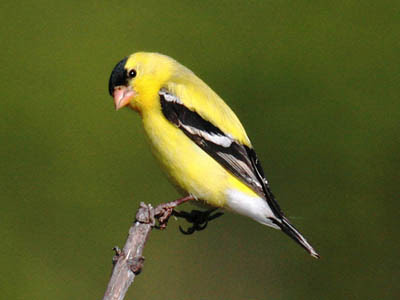 |
| American Goldfinch. Greg Gillson. |
Males are bright lemon yellow with black and white wings and tail, black cap. White under tail coverts. Pink bill.
Females are duller yellow below and brownish above. Lack black cap.
Winter birds are pale brown or gray, a touch of yellow on the throat of males.
These are birds of open country, fields with saplings, clear cuts, residential areas. They avoid dense forests, mountains, deserts. They visit feeders.
American Goldfinches are year-round residents in northeastern Colorado, winter visitors only throughout.
Yellow-rumped Warbler
These are abundant warblers across North America. Affectionately called “butter butts” by many birders, because of their bright yellow rumps that flash in flight.
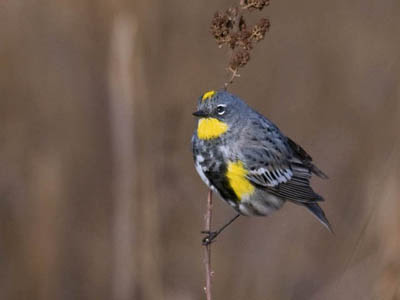 |
| Male Audubon’s Yellow-rumped Warbler. Greg Gillson. |
Western form (Audubon’s) with bright yellow throat and yellow rump. Large white wing patch.
Northern and Eastern form (Myrtle) with white throat, yellow rump, and two white wing bars.
Winter birds are dull gray brown, with bright yellow rump. Throat may be cream colored or white. Often difficult to tell the two forms apart in winter.
 |
| Winter Yellow-rumped Warbler. Greg Gillson. |
Breed in mountain or boreal conifers. Widespread in migration. Winter in low river bottoms, open weedy deciduous areas. Rarely come to feeders in winter.
Yellow-rumped Warblers are summer residents in central and western Colorado, spring and fall migrants only in eastern Colorado.
Yellow Warbler
The golden yellow sun packed all into one little bird! Appears to be an all-yellow bird.
 |
| Yellow Warbler. Greg Gillson. |
Some populations are bright yellow, some tend toward greenish on upper parts, some more golden. Yellow internal tail corners in flight.
Males with red breast streaking, again, variable by population.
Females somewhat to much paler yellow, some greenish, some whitish. Lack red streaks.
These birds are found in willow thickets on the edge of wetlands and ditches, stream sides in arid regions.
Yellow Warblers are summer residents in northern and western Colorado, spring and fall migrants throughout.
Pine Siskin
These small brown-streaked birds are relatives of the goldfinches. But you would never know it until they fly and sport yellow wing stripes and tail base. Usually in flocks.
 |
| Pine Siskin. Greg Gillson. |
These birds are streaked brown. In flight they have a yellow stripe down the length of the wing. The sides of the base of the tail is also yellow. Some birds are paler, some darker, others brighter yellow, others duller.
These birds are found in summer in northern conifer woods. Irregularly irrupt hundreds of miles southward. Frequent at feeders.
Pine Siskins are year-round residents in western Colorado, winter visitors only in eastern Colorado.
Western Kingbird
These yellow-bellied birds of the prairies often perch on power lines and fence lines.
 |
| Western Kingbird. Greg Gillson. |
These birds are pale gray on the head and breast. Brown wings. The belly is lemon yellow. Black tail has white outer tail feathers, especially obvious in flight.
These are birds of prairies, deserts, pastures, often near water.
Western Kingbirds are summer residents throughout Colorado.
Lesser Goldfinch
Lesser Goldfinches maintain their bright yellow plumage all year–even in the winter when American Goldfinches are rather brown and colorless.
 |
| Male Lesser Goldfinch. Greg Gillson. |
These tiny birds are bright yellow below (including under the tail), and green or black on the back. The wings and tail are black and white. Males have a black cap, which the females lack.
These birds are found near water in arid regions of the West and Southwest. They are common in residential areas, too, and come to bird feeders.
Lesser Goldfinches are year-round residents in southwestern and south-central Colorado, summer residents only throughout the rest of Colorado.
Western Tanager
Numbers of these bright black and yellow birds may show up overnight in backyards in spring migration. Then they disappear the next night.
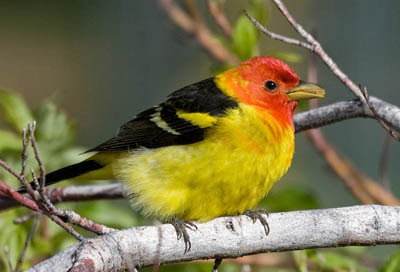 |
| Western Tanager. Greg Gillson. |
Males are brilliant golden yellow with black back, wings, and tail, and a red or orange face. Swollen yellow bill.
Females are more green or gray, with darker wings and tail. Lack red face.
They are found in a variety of wooded habitats, usually conifers or mixed conifer woods, and residential areas with large trees, including mature conifers. Usually don’t visit feeders.
Western Tanagers are summer residents in western Colorado, spring and fall migrants in eastern Colorado.
Common Yellowthroat
These buttery yellow birds are abundant in the marsh vegetation.
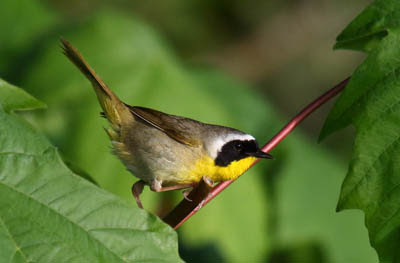 |
| Male Common Yellowthroat. Greg Gillson. |
These skulkers have bright yellow throats and yellow undertail coverts. Males have a black domino mask edged broadly in white, which females lack. Upperparts are dull olive-green.
Immature males in fall show a shadowed black mask.
Found in damp situations and heavy deciduous brambles following clear cuts.
Common Yellowthroats are summer residents in eastern Colorado, absent elsewhere at higher elevations.
Yellow-breasted Chat
These unique larger yellow birds may sing day and night, and include whistles and crow-like cawing, often given in a display flight.
 |
| Yellow-breasted Chat. Greg Gillson. |
These birds are greenish above with bright yellow breast and white belly. They have a dark mask bordered with white.
These birds live in tangles and wet woods.
Yellow-breasted Chats are summer residents throughout Colorado.
Cedar Waxwing
These crested birds with yellow band on the end of the tail are often found in flocks. They eat flying insects in summer, fruit and berries the rest of the year.
 |
| Cedar Waxwing. Greg Gillson. |
These birds are fawn-brown above, with dark gray wings and tail. They have a black mask and wispy crest. The belly is yellow. The wings have waxy red drops on the end of the tertials. The end of the tail has a brilliant yellow tail band.
They are found in open habitats with berries, including juniper woodlands and towns in winter.
Cedar Waxwings are year-round residents in northern-central Colorado, winter visitors only elsewhere.
Yellow-headed Blackbird
These blackbirds with yellow heads are found in marshes in the West.
 |
| Yellow-headed Blackbird. Greg Gillson. |
Males are glossy black with bright golden-yellow head and breast. White wing patches.
Females are duller brown with mottled yellow breast.
These birds nest in cattail marshes in prairies. Winter in large flocks in agricultural areas.
Yellow-headed Blackbirds are summer residents throughout Colorado.
Wrapping Up
Colorado boasts a vibrant array of colorful birds that will dazzle your eyes and delight your spirit. Here are some more of the most stunning feathered friends you might encounter:
Summer Beauties:
- Western Tanager: Males flaunt a fiery orange body, black wings, and a yellow head, making them one of the most vibrant birds in the state. Look for them in coniferous forests and mountain meadows.
- Lazuli Bunting: The state bird of Colorado, males showcase a deep blue head and breast, contrasted by white wing bars and a chestnut back. They frequent open fields and grasslands.
- American Goldfinch: These tiny marvels transform into sunshine on wings during breeding season, with bright yellow bodies, black caps, and black wing bars. You’ll find them in fields, meadows, and gardens.
- Broad-tailed Hummingbird: Males boast an iridescent emerald green throat and back, along with a fiery red neck patch. Watch them hover and sip nectar from flowers across diverse habitats.
Year-round Charmers:
- Clark’s Nutcracker: These large, intelligent birds sport a striking black and white plumage with a bright blue patch on their wings. They frequent mountain forests and meadows, readily cracking nuts with their powerful beaks.
- Steller’s Jay: These bold and vocal birds showcase a stunning combination of blue, black, and white. They flash their long blue tails through forests and woodlands, adding a dash of personality to the scenery.
- Northern Flicker: These woodpeckers announce their presence with a loud “flicker” call and display a handsome yellow breast, spotted back, and red nape. You’ll find them drumming on trees and foraging for insects in various habitats.
- Black-headed Grosbeak: Males sport a bright yellow body, black head and bib, and white wing bars. Look for them in open woodlands, parks, and backyards, where they sing a melodious song.
Frequently Asked Questions
What kind of bird has a red throat in Colorado?
There are several possibilities for birds with a red throat in Colorado, depending on the time of year, habitat, and other details. Here are some likely candidates:
Summer residents (April-October):
- Western Tanager: Males boast a fiery orange body, black wings, and a bright red throat, making them one of the most vibrant birds in the state. They frequent coniferous forests and mountain meadows.
- Broad-tailed Hummingbird: Males display an iridescent emerald green throat and back, along with a fiery red neck patch. Watch them hover and sip nectar from flowers across diverse habitats.
- Scarlet Macaw (introduced species): While not native to Colorado, escaped or released individuals of this large parrot can be seen occasionally, sporting a vibrant red, yellow, and blue plumage with a prominent red throat patch. Their loud squawks are a giveaway.
Year-round residents:
- Northern Cardinal: The male cardinal, Colorado’s state bird, is a familiar sight with its fiery red breast, black mask, and crest. You’ll find them in backyards, forests, and shrublands.
- American Robin: While more known for its rusty red breast, male robins sometimes show a faint reddish tinge on their throat, especially during breeding season. Look for them in lawns, parks, and woodlands.
- Red-throated Loon: Found on mountain lakes and ponds, this diving bird shows a black-and-white checkered back and a distinctive red throat pouch during breeding season.
Migratory birds (present during different seasons):
- Black-throated Blue Warbler: Males of this warbler species sport a beautiful blue back and wings, along with a black throat and a bright orange crown. They frequent dense forests and woodlands during breeding season (May-July).
- Flame-throated Hummingbird (rare vagrant): This stunning hummingbird, with its iridescent emerald green back and fiery red throat, is a rare visitor to Colorado, but sightings have been documented. Look for them in mountainous areas with blooming flowers.
What is the orange breasted Colorado bird?
The American Robin is a common year-round resident in Colorado, so you have a good chance of finding them in a variety of habitats around the state:
Urban Areas:
- Backyards and Parks: Robins readily frequent lawns, gardens, and open spaces within towns and cities. They forage for worms, insects, and berries, often taking advantage of feeders and birdbaths.
- Tree-lined Streets and Bushlands: Look for them hopping and perching on trees and shrubs along public spaces and residential areas.
Rural Areas:
- Farmlands and Meadows: Open agricultural fields and meadows provide ample foraging opportunities for robins. They readily utilize fence posts and trees for perching and singing.
- Forests and Woodlands: While not exclusively found in dense forests, robins frequent edges and clearings within woodlands, seeking out berries and insects among the trees.
- Riparian Areas: Look for them near streams, ponds, and wetlands, where they might find fruits and insects in these habitats.
Mountain Regions:
- Lower Mountain Slopes and Valleys: Robins adapt well to moderate elevations, so you can find them in valleys and lower slopes within the mountains. Look for them in meadows, open forests, and near human settlements.
What is the small yellow bird in Colorado?
The Yellow Warbler is a common sight in North America, charming audiences with its bright feathers and cheerful songs. But beyond its beauty, this little bird hides some fascinating facts you might not know:
Champions of Migration:
- Longest Migration Distance: Among North American songbirds, Yellow Warblers boast one of the longest migration journeys, traveling up to 10,000 miles (16,000 km) from their South American wintering grounds back to their North American breeding grounds.
- Double Migration: Some populations even undertake a “double migration,” breeding twice in a single season – once in the southernmost part of their range and again further north!
Masters of Mimicry:
- Vocal Talent: While Yellow Warblers have their own beautiful song, they are also skilled mimics, incorporating sounds from other bird species into their song repertoire. This can confuse predators and even attract mates!
- Deceptive Calls: To protect their nests, Yellow Warblers sometimes mimic the alarm calls of larger, more aggressive birds like hawks or owls, scaring away potential predators.
Super Moms and Tiny Chicks:
- Egg Laying Champs: Female Yellow Warblers can lay an impressive clutch of 3-6 eggs, and have even been documented laying up to 12 eggs on rare occasions!
- Superfast Builders: These dedicated mothers can build a complete nest in as little as 4 days, weaving together leaves, twigs, and grasses.
- Parental Teamwork: Interestingly, while the female builds the nest and incubates the eggs, both parents share the responsibility of feeding their chicks once they hatch.
Related Articles:
See photos and learn about the most common backyard birds in Colorado, regardless of color.
Here’s a quick tutorial of how I would teach you to identify birds: 7 Steps to Identify Birds!
Birds with red heads in North America.
Yellow-and-black birds in North America.










